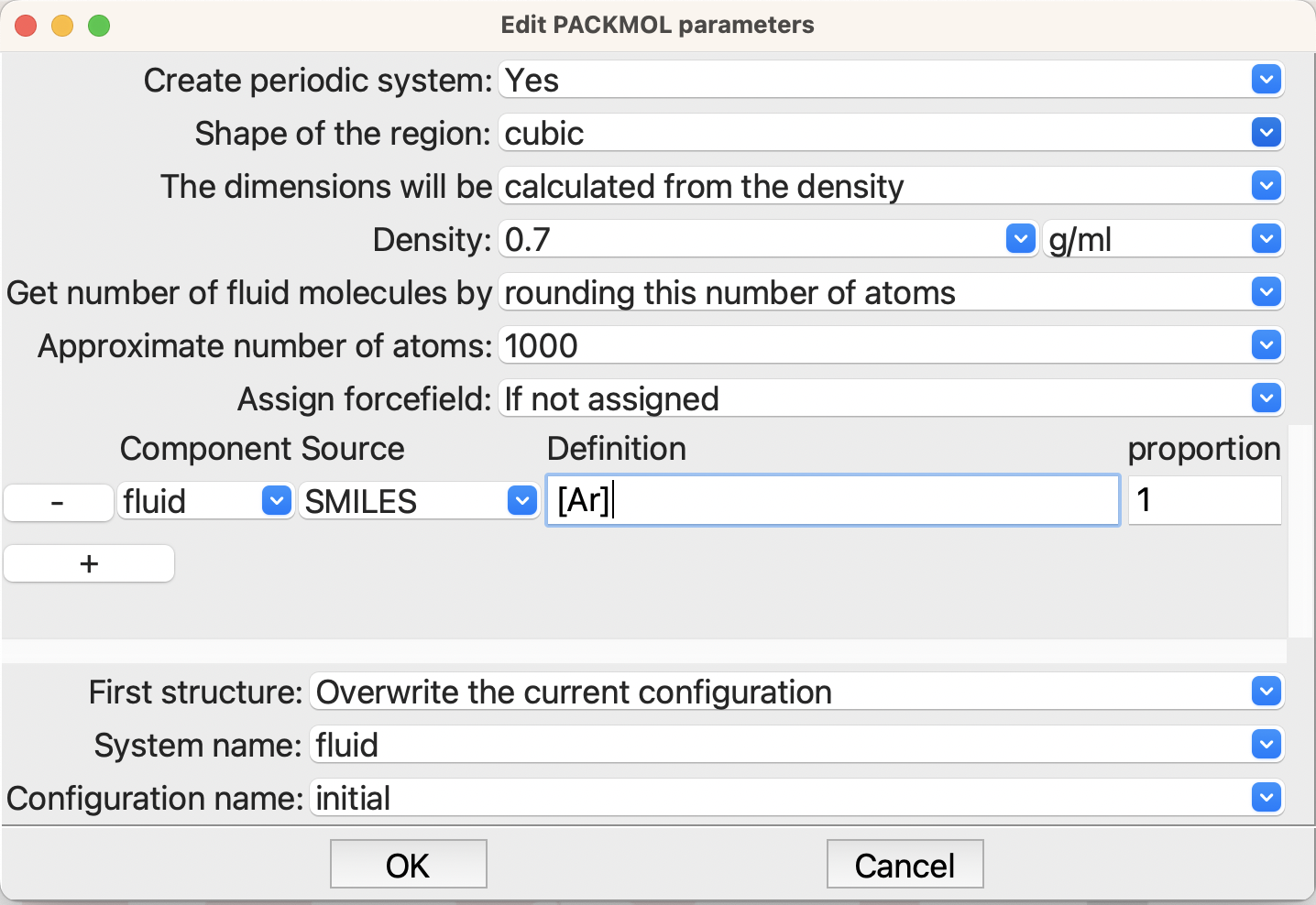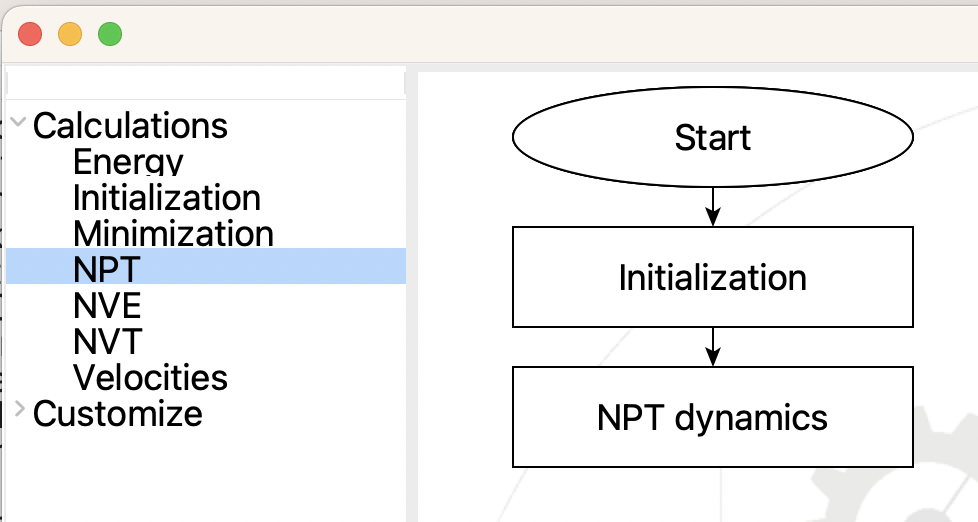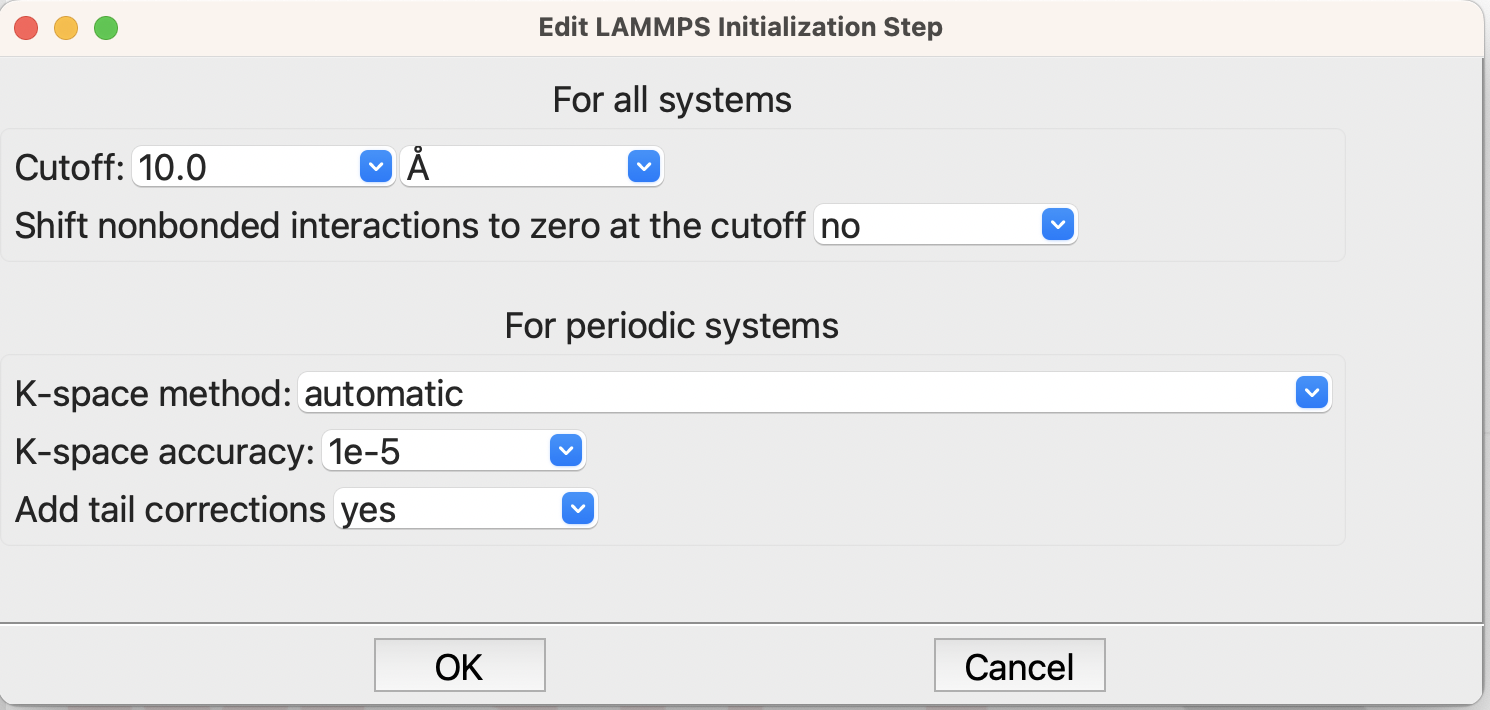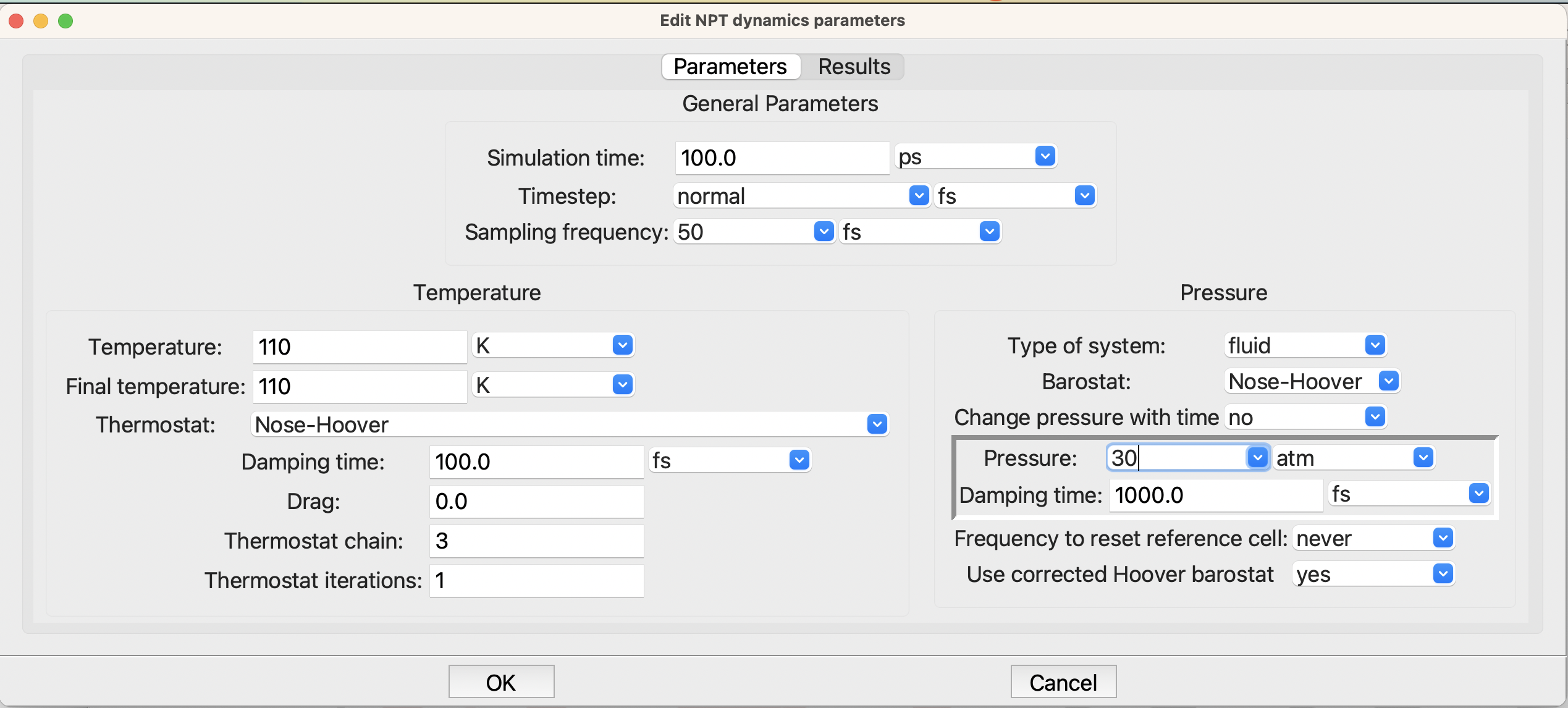Getting Started#
Installation#
The LAMMPS step is probably already installed in your SEAMM environment, but if not or if you wish to check, follow the directions for the SEAMM Installer. The graphical installer is the easiest to use. In the SEAMM conda environment, simply type:
seamm-installer
or use the shortcut if you installed one. Switch to the second tab, Components, and check for LAMMPS-step. If it is not installed, or can be updated, check the box next to it and click Install selected or Update selected as appropriate.
The non-graphical installer is also straightforward:
seamm-installer install --update lammps-step
will ensure both that it is installed and up-to-date.
Example of NPT dynamics#
Here is a simple example that will run quickly on any machine, including your laptop. We’ll simulate an argon fluid at 110 K and 30 atm pressure using a periodic cell containing 1000 atoms.
First we need a flowchart for the simulation. It
needs to have three steps:

Flowchart for Ar fluid NPT simulation#
Create a flowchart that looks like the above. If you need help doing this, please go to the main SEAMM tutorials, then come back here once you are more familiar with the interface. We’ll edit each step in the next paragraphs, so just create a flowchart that looks like the above.
The three steps are straightforward: the first establishes the forcefield that will be used in all subsequent steps unless charge by another Forcefield Step; the Packmol step will create the fluid system of argon; and the LAMMPS step, run the molecular dynamics.
Now edit the forcefield step and set the forcefield to OPLS-AA, like this:

Setting the forcefield for the simulation#
You will need to change the forcefield repository to oplsaa.frc. Each forcefield may have different variants in the file; however, for this calculation the default is all we need.
Next edit the Packmol Step and set it up as shown:

Building the Ar fluid system#
Here you will need to change to a periodic system. Check that Packmol will build a cubic system with a density of 0.7. Set the approximate number of atoms to 1000 – that will be the number of argon atoms in your simulation box. If you wish you can change the system and configuration names, but they will not be used anywhere else in this example, so you can leave them with the defaults, if you wish.
The last step is to create the LAMMPS simulation. When you edit the LAMMPS Step you will see a dialog for creating a flowchart that is similar to the main one that you just created. However, the choice of steps on the left is specific to LAMMPS. Create a LAMMPS flowchart like this:

Subflowchart for LAMMPS#
Now edit the steps. There is actually nothing that you need to change in the Initialization Step. The defaults are usually fine:

The LAMMPS initialization step#
There is more needed in the NPT dynamics step:

The LAMMPS NPT step#
Here you need to change the two temperatures on the left side to 110 K and the pressure, on the right, to 30 atm. This is in the liquid part of the phase diagram for argon, as we can see at the nice NIST fluid properties website:

Tabulation of Argon fluid properties at NIST#
Experimentally the density should be about 1.256 at the temperature and pressure that we have chosen. Let’s see what we get! Submit the calculation to your Dashboard and check the results. It will take about a minute to run. You should then find something similar to this in job.out:
Step 3: LAMMPS 2022.10.31+4.g1c55ce2.dirty
LAMMPS using the serial version.
Step 3.2: NPT dynamics
100.0 ps of canonical (NPT) dynamics at 110.0 K using a Nose-Hoover
thermostat. The thermostat will use a chain of 3 thermostats with 1
subcycles and a drag factor of 0.0.
The run will be 50,000 steps of dynamics sampled every 25 steps.
Analysis of trajectory_npt_3_2.seamm_trj
Std Error Time to
Property Value of mean convergence tau inefficiency
-------------------- --------- --------- ----------- -------- ------------
T = 110.568 ± 0.595 0.00 fs 25.0 fs 2.0
P = 68.086 ± 39.845 0.00 fs 25.0 fs 1.2
density = 1.253 ± 0.001* 9.00 ps 546.3 fs 22.9
a = 37.547 ± 0.014* 9.00 ps 547.1 fs 22.9
b = 37.547 ± 0.014* 9.00 ps 547.1 fs 22.9
c = 37.547 ± 0.014* 9.00 ps 547.1 fs 22.9
Etot = -687.190 ± 178.422 0.00 fs 400.8 fs 17.0
Eke = 329.250 ± 1.771 0.00 fs 25.0 fs 2.0
Epe = -1029.024 ± 163.311 0.00 fs 358.3 fs 15.3
Epair = -1029.024 ± 163.311 0.00 fs 358.3 fs 15.3
Wrote the final structure to 'final_structure.mmcif' and 'final_structure.cif' for viewing.
The density predicted – third line in the table – is 1.253, very close to the experimental value of 1.256. Of course, Argon is about the easiest possible case! However, you should expect fluid densities within 1-2% with a good forcefield.
If you open the folder labeled ‘3’ on the left of the Dashboard, you will find a collection of graphs listed. The last one is the density. If you click on it you will see a graph like the following:

The density of the Argon during the simulation#
The subgraph on the left shows the density vs time as a green line. It started at a low value of 0.7 because we asked Packmol to create a system with that density. Initially it actually dropped lower because some atoms in the as-built structure were too close together and pushed everything apart. Then the pressure rapidly climbs to about 1.25 after 10 ps, and then fluctuates around that value for the rest of the run. SEAMM automatically determines when the property has settled down and computes the average and standard error that you saw in the table above. It is also indicated by the black horizontal line in the graph.
The graph on the right shows the autocorrelation function and an exponential fit to it, which is used to get the time constant of the autocorrelation. In this case the time constant is about 500 fs, or 0.5 ps. This means that the density at a time t is still correlated with the density 0.5 ps earlier, meaning that there is little new information gained by sampling that density. This is the basis of the statistical inefficiency in the table, which was about 23 for the density. In this calculation we sampled the properties every 50 ps, which was fine for the pressure, for example, but is about 23 times more often than useful for the density. The results shown are correct because the code corrects for the oversampling. It just means that the trajectory file is about 23 times larger than it needs to be and the code did some more work than necessary to correctly predict the density and its standard error.
That should be enough to get started. For more detail about the functionality in this plug-in, see the User Guide.

